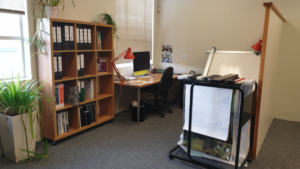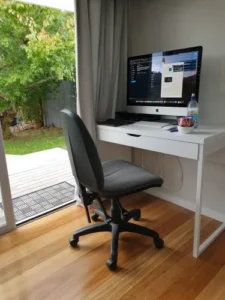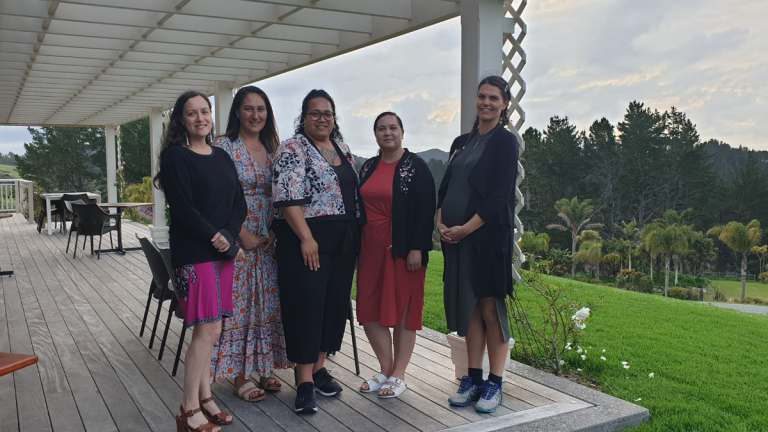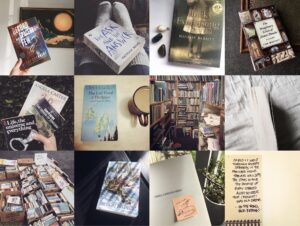It’s been three weeks since the first Te Papa Tupu wānanga in Te Whanganui-ā-Tara where Jade met her mentor Simon Minto, and the other writers and mentors on the programme. Jade reflects on this past week and her work/life/writing balance.
It’s 8pm on a Thursday evening, and I’m sitting on the floor of a bach in Kororāreka. We’re all together in one of the bedrooms, even though there’s a full lounge and three other bedrooms in the house. My cousin Nicki is laying on the sofa, very hapū. Ana, Hope and I are sitting on the floor around the room. Felicity and Aleisha are in the kitchen, unpacking after a trip to the store. We’re here for our work retreat for the design studio I run, along with this team of awesome wāhine toa. It’s the first wānanga since I started the business 2 years and 3 months ago, and we’ve grown so much in that time. It really feels like a waka, a vehicle for our collective aspirations, now, rather than my moemoeā alone.
Ten hours ago, I sat in the Council chambers in Whangārei. Councillor Benney sat to my left, Councillor Couper to my right, and Councillor Phil Halse chaired the meeting. It was the first meeting of Te Kārearea, a standing committee made up of eight elected Councillors and eight hapū appointed members. The committee, which has formally delegated powers, was established to support hapū and Māori participation in local government. It was our first meeting, an opportunity to get to know our Council counterparts, and to get a hang of the standing orders and formal meetings procedures. We also discussed Māori wards, which Council will consider at their full Council meeting next week.

Twenty four hours ago, I sat at my drawing board in our offices in Whangārei, working on the design of a new accommodation facility for tai tamariki associated with education and training, lead pencil on trace, working on the floor plan, arranging the spaces in my schedule of accommodation within the grid I’ve developed. In the next room, a whenua rangahau group led by my cousin (and hoamahi) Nicki, where a small group of hapū members are poring over land court records, minutes books, working through whakapapa. So often our office operates as a kaumātua drop in centre, a hapū wānanga small, a library.
Forty eight hours ago, I was at Kensington Fitness at McKay Stadium, Kensington, running on the treadmill. That day, I did the cross-trainer and the treadmill. Usually, I would also stretch and use the sauna, maybe do some light weights. That day, I was short on time, trying to get in at least forty minutes of exercise before the gym closed at 9pm. I had stayed late after work, making final edits to the pages I intended to send my mentor for Te Papa Tupu. 5pm turned into 7.45pm, and I almost didn’t go to the gym, but at the roundabout at the top of Bank Street, I made an impulse decision to try to get to the gym in time, anyway.
As I sit here in Kororāreka, it occurs to me that this whare – that I’m informed used to be accommodation for hospitality workers and a notorious party house – would be an ideal writing retreat. Throughout the Te Papa Tupu programme, I have been confronted by the schism between the various spaces I occupy and the types of work I do. This isn’t a new feeling (I struggle switching between architectural work and writing / policy work, and generally need to set aside days for different kinds of tasks – design days, admin / coordination days, writing days). At the first Te Papa Tupu wānanga, we were advised to write daily. Immediately, I knew that wasn’t going to work for me, but felt confident I could make up for it on my dedicated writing days. I find having full days available for writing works better for me (obviously this is a luxury not everyone has).

Three days ago, I sat at my laptop, at home in my whare in Pārua Bay, working on my manuscript for Te Papa Tupu. Over Labour Weekend, I wrote the first draft of the first two chapters of my novel. On the Saturday, I wrote 6,000 words, on Sunday 5,000, and on Monday I wrote 2,000, for a total of 13,000 words. I also deleted 3,000 (a section that I completely rewrote and integrated into chapter two), so the net was more like 10,000.
I had always intended this to be a novel-length work (12 memory stories, with a present-day overarching narrative). Before Te Papa Tupu, I created a plan for 12 thematically linked short stories. I completed ten before I submitted. The overarching narrative was still only very loosely conceived.
Post my acceptance to Te Papa Tupu – when things became serious – I created a fairly detailed plan broken down by chapter, and then a rough outline of the scenes I want to cover in each chapter. I also wrote a description of each character, their relationships to each other, what they lack and what motivates them. I’ve made a schedule of the days I can dedicate to writing before mid-December with daily word counts. But in terms of the actual writing process, I visualise the scenes in my mind and write it down as I go, choosing the words that I think give it the right feel.
The structure I’ve chosen for my project is ambitious, and much like when I’m designing, the world of the story (like the world of the building) occupies my mind, and I find myself visiting it throughout the day. I feel like I’m possessed, and I won’t know peace until the story (or building) is resolved. It occurs to me that I write like I design – visually, imagining spaces and scenes in three dimensions, and then writing down or drawing what I see. To me, creating is about bringing my vision to life, drawing it out into the world. But it’s necessarily a two way process, with the writing or drawing modifying and shaping the image in my mind.
When I sent the draft chapters to my mentor Simon on Tuesday evening, I felt nervous. I have a perfectionist attitude to my work, and it’s difficult submitting writing that I know needs a lot of work. But I am also heartened by how my writing has improved since the first workshop, the tools we were given in Wellington as well as the new relationship with my mentor. So, I hope Simon thinks what I have sent him is good, and although I worry that he will think it is trash, I trust that even if it is, he will help me improve my writing. I know we’re on the same team, committed to achieving a positive outcome together.






